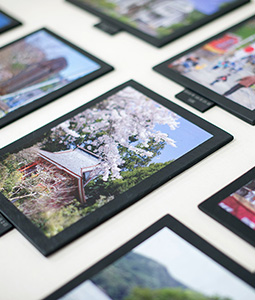Home > Highlighting JAPAN > Highlighting Japan February 2017 > Traditional Crafts
Highlighting JAPAN


The Land and the Sea
230 millions years in the making, Ogatsu slate suzuri are the calligrapher’s inkstone of choice.
Craftsman Shoichi Higuchi uses the tip of a chisel to indicate a barely noticeable centimeter-long discoloration in the dusty surface of the slab of slate he is working. It is, he explains, a small but not insignificant clot of iron, one of a number of unwanted objects that can be uncovered during the production process of suzuri inkstones, an industry that in the coastal town of Ogatsu, Miyagi Prefecture dates back more than 600 years.
Experienced slate craftsmen can usually size up a block of slate at a glance, but such imperfections often only become apparent once the production process has begun in earnest, says Higuchi, 63, as he chips away at a rectangular inkstone with one of six chisels he uses, the elongated wooden handle of which is wedged into his shoulder for extra leverage.
“Those blemishes are only small, but incredibly hard and can double the time it takes to produce one inkstone,” says Higuchi, who has been involved in the inkstone business in Ogatsu for over fifty years. “We often say that quality slate has the feel of a baby’s skin. It’s a pleasure to work with such a stone. It inspires great care and attention.”
Ogatsu is known in Japan for its high-grade slate and in particular the ink stones, which at one time accounted for 90 percent of domestically produced suzuri. That quality is a result of a unique blend of crystals, copper and iron that provide well-balanced “teeth” on which to grind the sticks of sumi ink, a compressed mixture of vegetable soot and glue that are traditionally used in calligraphy. That balance also means the slate cleaves easily, allowing ink stones to be easily made with matching covers, according to Takeshi Chiba of the local inkstone association.
“The slate being used here now was formed over a period of 230 million years, before dinosaurs even walked the earth,” says Chiba.
“There was a time when Ogatsu craftsmen would mine the slate from sixteen different mountains, each known for a variety of slate that was suitable for certain uses, such as roof tiles and inkstones.”
When Higuchi was a child there were hundreds of inkstone craftsmen in Ogatsu and the sound of slate being chiseled and polished would fill the streets near the wharf of this small fishing town on the Pacific Ocean.
“There was at least one person per household that was involved in producing them,” says Higuchi, adding that the majority of inkstones produced were for use in elementary schools, where calligraphy was once an important part of the curriculum. “It was not unheard of for one workshop to employ up to 200 people and at shipment time we’d fill fifty wooden crates up with inkstones – each one weighing in at 60 kg.”
The arrival of more competitive imports during the 1960s proved a watershed in Ogatsu’s suzuri history, forcing the once entirely handmade inkstone industry to turn to machine-pressed alternatives and sending craftsmen to cities such as Tokyo in search of alternative employment, according to Higuchi.
The declining birthrate and the demise of calligraphy in the classroom placed a further nail in the inkstone coffin. The March 2011 earthquake and tsunami, which killed more than 270 residents and washed away most of the town’s 1,660 homes, fisheries processing facilities and other businesses further impacted the industry.
Among the buildings destroyed was Higuchi’s home, where he had grown up helping his father and grandfather at the family inkstone business.
Like many other residents, Higuchi was forced to relocate to Sendai, the capital city of Miyagi Prefecture, a 90-minute drive away, though he continues to commute to Ogatsu, where today he is the only remaining suzuri craftsman in the local inkstone makers’ association.
Over the past twenty years, the development of other products, such as slate tableware, coasters, picture frames, and vases, has opened up new avenues of business, though the dearth of successors remains a concern, says Higuchi.
“There are one or two other independent craftsmen who are in their 70s and 80s, but at 63 I am the youngest,” says Higuchi. “We have two young apprentices, who come to study when they can. We can only hope that they continue, or a 600-year tradition may struggle to survive.”
© 2009 Cabinet Office, Government of Japan









